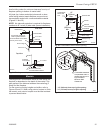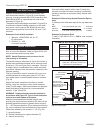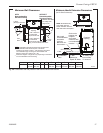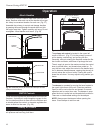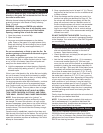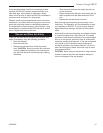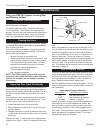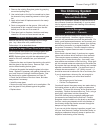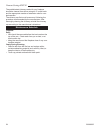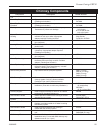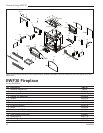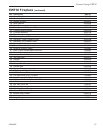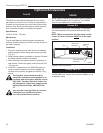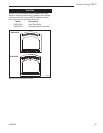
23
Vermont Castings EWF30
20008662
1. Remove the existing fiberglass gasket by grasping
an end and pulling firmly.
2. Use a wire brush or the tip of a screwdriver to clean
the channel of any remaining cement or bits of gas-
ket.
3. Apply a thin bead of fireplace cement to the newly-
cleaned groove.
4. Pack a new gasket into the groove. Wait until you
have placed all but a couple inches from the end
before you trim the end to an exact fit.
5. Place door back on fireplace, latch door and keep
closed for 1/2 hour to insure cement has set.
Replacing the Door Gaskets
Remove the door by lifting it straight up off its hinge
pins. Lay it face down on a padded surface.
Follow steps 1-4 as described above.
Replace Damaged Door Glass Immediately
Do not operate the fireplace with damaged glass door.
Use the following procedure for glass replacement.
NOTE: Replace glass only with the replacement glass
made for this unit, available from your authorized
dealer.
• Remove the door and loosen the retaining clips which
hold the glass to the door frame. Remove clips. Use
caution when handling broken glass.
• Examine the gasket that seals the glass to the door
frame. Replace if necessary with gasket obtained from
your local Vermont Castings’ Authorized Dealer. See
the directions for gasket replacement on Page 23.
• Check the flat surface of the door frame, and clear
away debris if necessary.
• Install the new glass.
• Secure the clips, being careful not to overtighten. Be
sure the glass is firmly seated against the gasket.
• Replace door.
The Chimney System
A Clean Chimney System is
Safer and Works Better
Although the combustion system in the EWF30 can re-
duce creosote formation dramatically, it is not a substi-
tute for regular inspection and cleaning of the chimney
and chimney connector.
Learn to Recognize —
and Avoid — Creosote
The EWF30 has been designed to reduce creosote
build-up significantly. However, regular chimney in-
spection and maintenance must still be performed. For
safety, good fireplace performance, and to protect your
chimney and chimney connector, inspect your chimney
and chimney connector on a regular schedule. Clean
the system if necessary. Failure to keep the chimney
and connector system clean can result in a serious
chimney fire.
When wood is burned slowly, it produces tar, organic
vapors and moisture which combine to form creosote.
The creosote vapors condense in the relatively cool
chimney flue of a slow-burning fire. As a result, creo-
sote residue accumulates on the flue lining. When ignit-
ed, this creosote makes an extremely hot fire within the
flue system that can damage the chimney and overheat
adjacent combustible material. If a significant layer of
creosote has accumulated —1/8” (3mm) or more — it
should be removed to reduce the risk of a chimney fire.
If you do experience a chimney fire, act promptly to:
• Close the primary air control lever and the
damper
• Get everyone out of the house.
• Call the Fire Department.
You should inspect the system every two weeks during
the heating season as part of a regular maintenance
schedule. To inspect the chimney, let the fireplace cool
completely. Remove the termination top. Then, using a
strong light, sight down into the chimney flue.
Clean the chimney using a specially designed brush
the same size and shape as the flue liner. Flexible
fiberglass rods are used to run the brush up and down
the liner, causing any deposits to fall to the bottom of
the chimney where they can be removed through the
damper on top of the fireplace.
If you can not do the chimney inspection yourself, con-
tact your local Vermont Castings’ Authorized Dealer, or
engage a professional chimney sweep to perform the
inspection and cleaning of the chimney.



